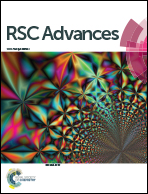Dual amplifying fluorescence anisotropy for detection of respiratory syncytial virus DNA fragments with size-control synthesized metal–organic framework MIL-101
Abstract
In order to eliminate the scattered light induced by the signal amplifier in fluorescence anisotropy (FA) assays, a nanosized metal–organic framework MIL-101, ranging from 80–500 nm, has been synthesized through a hydrothermal method with the addition of glycerol. We chose the 100 nm MIL-101 to enhance FA for label-free detection of the respiratory syncytial virus (RSV) gene sequence and the DNA-intercalating dye SYBR Green I (SGI) as the fluorophore, based on the different affinities of MIL-101 toward ssDNA and dsDNA. The nanosized MIL-101 has a negligible scattering effect owing to its smaller particle size, so all of the experimental data of FA values were smaller than the maximum initial anisotropy of 0.4. As a specific advantage, a dual amplification result of not only an increase in the FA value of SGI/ssDNA (r1) but also a decrease in the FA value of SGI/dsDNA (r2) was presented at the same time. Consequently, a larger FA value change Δr (Δr, Δr = r1 − r2) was obtained and contributed to improve the sensitivity. In addition, the quantitative detection of the target DNA (T) was achieved according to the relationship between Δr and the concentration of T. In the presence of MIL-101, the Δr is 7-fold higher than that without MIL-101 and achieved the sensitive and selective detection of RSV DNA.


 Please wait while we load your content...
Please wait while we load your content...